ASU researcher says human waste provides window into public health
University is home to National Sewage Sludge Repository, comprising samples from 200 wastewater treatment plants

It’s not touted on the side of a bus, but Arizona State University is full of it.
The university is home to the National Sewage Sludge Repository. Collected from 200 wastewater treatment plants, representing 10 percent of the U.S. population, it’s the largest archive of its kind in the country.
Row upon row of white freezers are packed with (at last count) more than 1,000 jars of sewage sludge in the Human Health Observatory lab. To most people, it’s a big pile of poo. To Rolf Halden, it’s a window into public health and habits.
The director of the Biodesign Center for Environmental Security, HaldenProfessor, Ira A. Fulton Schools of Engineering, School of Sustainable Engineering and the Built Environment; senior sustainability scientist, Julie Ann Wrigley Global Institute of Sustainability. lectured Wednesday about his work with the archive.
Cities have guts like we do, and wastewater treatment plants do the digestion. If wastewater treatment plants can’t clean something out, that’s a problem.
“We use them as observatories,” Halden said. “We use it to look at the toxic history.”
Sewage sludge analysis is a diagnostic tool, which reveals chemical regulation (or the lack thereof).
Flame retardants, antimicrobial soaps, bath salts and opioids all turn up in sewage.
“We don’t know who created the cocaine spike over the weekend, but we can measure it,” Halden said. “There’s a lot we can learn about studying wastewater.”
He said this sort of research could become more prevalent for its potential to point out public health concerns — if, for example, wastewater sludge shows a high concentrations of opioids, researchers could alert authorities to a previously undetected drug problem.
And since projections show that by 2050, two-thirds of the projected world population of 9.6 billion people will live in cities, the ability to diagnose human activities, consumption and health in urban cities will be key to understanding and managing human health and planetary sustainability.
Modern products exude debris that literally has nowhere to go.
“Earth is a big bubble,” Halden said. “Eventually, everything comes back to us.”
As an example of visible chemical pollution, Halden cited the five gyresA gyre in oceanography is any large system of circulating ocean currents, particularly those involved with large wind movements. Source: Wikipedia in the world’s oceans where plastic trash accumulates in Texas-sized agglomerations.
“This is one of the few pollutions we can see,” he said.
However, most chemical pollution is invisible.
“Pollution is present everywhere — including in you,” said Halden, who described it as “a chemical legacy.”
When a baby is born, it automatically carries a “toxic backpack” from everything the mother has ingested, sprayed on, rubbed on and inhaled in her life. A baby’s first meal is loaded with chemicals.
“This stuff doesn’t go away,” Halden said. “This is the chemistry we do today.”
Cities are a great place to study what people do, because everything is there. Cities can be studied as large living organisms. Urban metabolism dates to the 1960s.
The ASU Human Health Observatory analyzes what comes in to wastewater treatment plants and what goes out.
“We see the pollution being emitted, and we know it will be around forever,” Halden said. “We are a part of nature.”
The lecture was part of the Ethics @Noon series, hosted by the ASU Lincoln Center for Applied Ethics.
Top photo: Professor Rolf Halden, director of the Center for Environmental Security at the Biodesign Institute, talks about the research he's doing on non-degradable toxins that reside for generations in humans' fat layers, during a Wednesday lecture on Diagnosing the Health of Urban Populations. His findings are based on mass spectrometer findings on human waste from ASU's National Sewage Sludge Repository, with samples taken from across the country. Photo by Charlie Leight/ASU Now
More Science and technology

Celebrating 34 years of space discovery with NASA
This year, NASA's Hubble Space Telescope (HST) is celebrating its 34th anniversary of the world's first space-based optical telescope, which paved the scientific pathway for NASA's James Webb Space…

Making magic happen: Engineering and designing theme parks
The themed entertainment industry is widespread and diverse, encompassing everything from theme parks to aquariums, zoos, water parks, museums and more. The Theme Park Engineering and Design…

AI-equipped feeders allow ASU Online students to study bird behavior remotely
ASU Online students are participating in a research opportunity that's for the birds — literally. Online Bird Buddies is a project that allows students to observe birds remotely, using bird feeders…